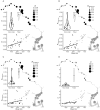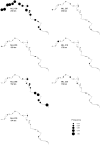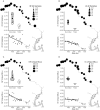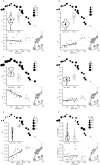Going With the Flow? Relative Importance of Riverine Hydrologic Connectivity Versus Tidal Influence for Spatial Structure of Genetic Diversity and Relatedness in a Foundational Submersed Aquatic Plant
- PMID: 40336545
- PMCID: PMC12058210
- DOI: 10.1002/ece3.71264
Going With the Flow? Relative Importance of Riverine Hydrologic Connectivity Versus Tidal Influence for Spatial Structure of Genetic Diversity and Relatedness in a Foundational Submersed Aquatic Plant
Abstract
Genetic connectivity in rivers is generally high, and levels of genotypic and genetic diversity of riverine species are expected to accumulate in downstream locations. Genetic structure of marine and estuarine species is less predictable, even though hydrologic connectivity is also expected to be relatively high in those ecosystems. These observations have been generated across different species and locations such that our understanding of the effects of hydrologic connectivity in the same river, spanning tidal and nontidal habitats, remains incomplete. To control for species and location, we quantified diversity in 941 samples of Vallisneria americana Michx. (Hydrocharitaceae) collected from 36 sites along the species' entire distribution in the tidal and nontidal Potomac River of Maryland, Virginia, and the District of Columbia, USA. Using 10 microsatellite loci, we found 507 unique multilocus genotypes (MLGs) that were collapsed to 482 multilocus lineages (MLLs). Fifty-three MLLs were found multiple times across the riverscape, accounting for over 54% of the genotyped shoots. We found some evidence supporting connectivity throughout the river and stronger evidence that tidal regime drives genotypic and genetic structure within V. americana. Extensive clonality, including two MLLs spanning 230 and 152 km, limits diversity in the nontidal reaches and contrasts with very little evidence of clonal reproduction in tidal reaches. Genetic differentiation, structure, and pairwise relatedness of sampled shoots and MLLs also differed by tidal reach, with the nontidal Potomac having higher levels of relatedness, lower allelic diversity, and higher heterozygosity. The differences in spatial distribution of genetic diversity suggest very different outlooks for V. americana adaptation and acclimation to perturbations in tidal and nontidal regions of the Potomac, which lead to different recommendations for restoration of the same species in the same river.
Keywords: clonality; resilience; restoration ecology; spatial genetic structure; submersed aquatic vegetation.
© 2025 The Author(s). Ecology and Evolution published by British Ecological Society and John Wiley & Sons Ltd.
Conflict of interest statement
The authors declare no conflicts of interest.
Figures










References
-
- Alberte, R. S. , Suba G. K., Procaccini G., Zimmerman R. C., and Fain S. R.. 1994. “Assessment of Genetic Diversity of Seagrass Populations Using DNA‐Fingerprinting – Implications for Population Stability and Management.” Proceedings of the National Academy of Sciences of the United States of America 91, no. 3: 1049–1053. - PMC - PubMed
-
- Alberto, F. , Gouveia L., Arnaud‐Haond S., Perez‐Llorens J. L., Duarte C. M., and Serrao E. A.. 2005. “Within‐Population Spatial Genetic Structure, Neighbourhood Size and Clonal Subrange in the Seagrass Cymodocea nodosa .” Molecular Ecology 14, no. 9: 2669–2681. - PubMed
-
- Arnaud‐Haond, S. , Duarte C. M., Diaz‐Almela E., Marba N., Sintes T., and Serrao E. A.. 2012. “Implications of Extreme Life Span in Clonal Organisms: Millenary Clones in Meadows of the Threatened Seagrass Posidonia oceanica .” PLoS One 7, no. 2: e30454. 10.1371/journal.pone.0030454. - DOI - PMC - PubMed
Associated data
LinkOut - more resources
Full Text Sources

